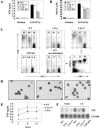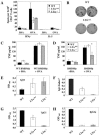Novel lymphotoxin alpha (LTalpha) knockout mice with unperturbed tumor necrosis factor expression: reassessing LTalpha biological functions
- PMID: 16705172
- PMCID: PMC1489085
- DOI: 10.1128/MCB.01751-05
Novel lymphotoxin alpha (LTalpha) knockout mice with unperturbed tumor necrosis factor expression: reassessing LTalpha biological functions
Abstract
Lymphotoxin alpha (LTalpha) can exist in soluble form and exert tumor necrosis factor (TNF)-like activity through TNF receptors. Based on the phenotypes of knockout (KO) mice, the physiological functions of LTalpha and TNF are considered partly redundant, in particular, in supporting the microarchitecture of the spleen and in host defense. We exploited Cre-LoxP technology to generate a novel neomycin resistance gene (neo) cassette-free LTalpha-deficient mouse strain (neo-free LTalpha KO [LTalphaDelta/Delta]). Unlike the "conventional" LTalpha-/- mice, new LTalphaDelta/Delta animals were capable of producing normal levels of systemic TNF upon lipopolysaccharide (LPS) challenge and were susceptible to LPS/D-galactosamine (D-GalN) toxicity. Activated neutrophils, monocytes, and macrophages from LTalphaDelta/Delta mice expressed TNF normally at both the mRNA and protein levels as opposed to conventional LTalpha KO mice, which showed substantial decreases in TNF. Additionally, the spleens of the neo-free LTalpha KO mice displayed several features resembling those of LTbeta KO mice rather than conventional LTalpha KO animals. The phenotype of the new LTalphaDelta/Delta mice indicates that LTalpha plays a smaller role in lymphoid organ maintenance than previously thought and has no direct role in the regulation of TNF expression.
Figures






Similar articles
-
Membrane lymphotoxin contributes to anti-leishmanial immunity by controlling structural integrity of lymphoid organs.Eur J Immunol. 2002 Jul;32(7):1993-2003. doi: 10.1002/1521-4141(200207)32:7<1993::AID-IMMU1993>3.0.CO;2-F. Eur J Immunol. 2002. PMID: 12115620
-
Independent protective effects for tumor necrosis factor and lymphotoxin alpha in the host response to Listeria monocytogenes infection.Infect Immun. 2005 Aug;73(8):4787-92. doi: 10.1128/IAI.73.8.4787-4792.2005. Infect Immun. 2005. PMID: 16040991 Free PMC article.
-
Distinct contributions of TNF and LT cytokines to the development of dendritic cells in vitro and their recruitment in vivo.Blood. 2003 Feb 15;101(4):1477-83. doi: 10.1182/blood.V101.4.1477. Blood. 2003. PMID: 12560241
-
Dissecting the role of lymphotoxin in lymphoid organs by conditional targeting.Immunol Rev. 2003 Oct;195:106-16. doi: 10.1034/j.1600-065x.2003.00071.x. Immunol Rev. 2003. PMID: 12969314 Review.
-
The role of lymphotoxin-α in rheumatoid arthritis.Inflamm Res. 2018 Jun;67(6):495-501. doi: 10.1007/s00011-018-1139-6. Epub 2018 Mar 14. Inflamm Res. 2018. PMID: 29541795 Review.
Cited by
-
Curcumin: an orally bioavailable blocker of TNF and other pro-inflammatory biomarkers.Br J Pharmacol. 2013 Aug;169(8):1672-92. doi: 10.1111/bph.12131. Br J Pharmacol. 2013. PMID: 23425071 Free PMC article. Review.
-
Mpeg1 is not essential for antibacterial or antiviral immunity, but is implicated in antigen presentation.Immunol Cell Biol. 2022 Aug;100(7):529-546. doi: 10.1111/imcb.12554. Epub 2022 May 12. Immunol Cell Biol. 2022. PMID: 35471730 Free PMC article.
-
Targeted depletion of lymphotoxin-alpha-expressing TH1 and TH17 cells inhibits autoimmune disease.Nat Med. 2009 Jul;15(7):766-73. doi: 10.1038/nm.1984. Epub 2009 Jun 28. Nat Med. 2009. PMID: 19561618
-
Lymphotoxin α revisited: general features and implications in rheumatoid arthritis.Arthritis Res Ther. 2011 Jul 26;13(4):232. doi: 10.1186/ar3376. Arthritis Res Ther. 2011. PMID: 21861866 Free PMC article. Review.
-
Deletion of P2Y2 receptor reveals a role for lymphotoxin-α in fatty streak formation.Vascul Pharmacol. 2016 Oct;85:11-20. doi: 10.1016/j.vph.2016.06.001. Epub 2016 Jun 26. Vascul Pharmacol. 2016. PMID: 27355755 Free PMC article.
References
-
- Abe, K., F. O. Yarovinsky, T. Murakami, A. N. Shakhov, A. V. Tumanov, D. Ito, L. N. Drutskaya, K. Pfeffer, D. V. Kuprash, K. L. Komschlies, and S. A. Nedospasov. 2003. Distinct contributions of TNF and LT cytokines to the development of dendritic cells in vitro and their recruitment in vivo. Blood 101:1477-1483. - PubMed
-
- Aggarwal, B. B. 2003. Signalling pathways of the TNF superfamily: a double-edged sword. Nat. Rev. Immunol. 3:745-756. - PubMed
Publication types
MeSH terms
Substances
Grants and funding
LinkOut - more resources
Full Text Sources
Other Literature Sources
Molecular Biology Databases
Research Materials
